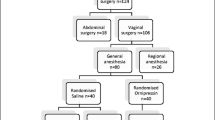Abstract
Introduction
The use of vasopressin and other vasoconstrictive agents to reduce blood loss during laparoscopic myomectomy significantly reduces blood loss and operative time. However, serious cardiovascular complications following the use of intra-myometrial injection of vasopressin solution have also been reported. Most of these side effects are believed to be due to inadvertent intravascular injection of vasopressin solution.
Aims and Objectives
To describe a new design of an injection needle, Pisat’s Visual Vasopressor Injection Needle (VVIN), that can be used during laparoscopic myomectomy to minimise the incidence of an inadvertent intravascular injection of a vasoconstrictor solution.
Results
A total of 53 patients who underwent laparoscopic myomectomy at various hospitals in Mumbai, India, were studied over a period of two years. Out of these, 23 patients were operated upon using a standard 5-mm laparoscopic injection needle, and 30 patients were operated upon by using a VVIN. Out of the 23 patients in whom a regular needle was used, four patients (17.39%) demonstrated a significant (over 20 percent of pre-injection value) but transient elevation in pulse and blood pressure readings at 1-min post-injection. This gradually returned to baseline at 10 min after the injection. None of the 30 patients in whom VVIN was used after confirming a negative aspiration demonstrated any significant change in post-injection pulse or blood pressure recordings.
Conclusions
Using a VVIN during a laparoscopic myomectomy enables the surgeon to detect an inadvertent vascular puncture very early, even in a small calibre blood vessel, and with much more sensitivity than a regular needle. This increases patient safety during the intra-myometrial injection of a vasoconstrictive agent during myomectomy and reduces the incidence of catastrophic complications.


Similar content being viewed by others
References
Mettler L, Schollmeyer T, Tinelli A, et al. Complications of uterine fibroids and their management, surgical management of fibroids, laparoscopy and hysteroscopy versus hysterectomy, haemorrhage, adhesions, and complications. Obstet Gynecol Int. 2012;9:2012.
Song T, Kim MK, Kim ML, et al. Use of vasopressin vs epinephrine to reduce haemorrhage during myomectomy: a randomized controlled trial. Eur J Obstet Gynecol Reprod Biol. 2015;31(195):177–81.
Tinelli A. Uterine fibroid pseudocapsule: an update of its importance in fibroid management and female reproduction. Int J Gynecol Obstet Reprod Med Res. 2014;1(1):7–10.
Pisat S, van Herendael B. Pisat’s visual vasopressor injection needle: an innovative tool for increasing patient safety in laparoscopic myomectomy. Surg Technol Int. 2017;9:30.
Author information
Authors and Affiliations
Corresponding author
Ethics declarations
Conflict of interest
Dr Sanket Pisat declares that he has no conflict of interest.
Additional information
Dr. Sanket Pisat is a Gynaecological Endoscopic Surgeon in Department of Gynaecological Minimal Access Surgery, Akanksha Hospital, Mumbai, India.
Rights and permissions
About this article
Cite this article
Pisat, S.V. Pisat’s Visual Vasopressor Injection Needle: A New Device for Increasing Patient Safety in Laparoscopic Myomectomy. J Obstet Gynecol India 67, 451–453 (2017). https://doi.org/10.1007/s13224-017-1048-6
Published:
Issue Date:
DOI: https://doi.org/10.1007/s13224-017-1048-6



